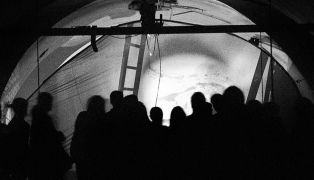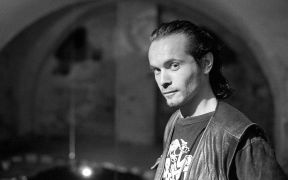“Many years later, as he faced the firing squad, Colonel Aureliano Buendía was to remember that distant afternoon when his father took him to discover ice.”
G.G. Marquez, first line, first chapter, of One Hundred Years of Solitude
The basic idea, is this: I proposed a rotating camera facing toward a sculpture of a dark sphere pole by gravity, transforming kinetic energy onto film footage. This later became the setting for a performance.
Since the space that I used was also for storage, I worked contingent to its purpose, using it as a studio and laboratory during my residency.
I stuck to the form of polarity, using the staged event — the first part of the performance — in a normal 3D space, combined with a projection and shadow play on a 2D screen surface, allowing it to be both a theatrical and cinematic experience at once.
Using one basic storyline from scenes relating to One Hundred Years of Solitude, I understand what ‘sort of languages’ I am using in my pieces, and parallels between these media. The performance lasted half an hour and finished at midnight.
The finale was formed by a giant bang (of fireworks, sounding like gunfire), while I descended into the room below — the ice cellar — together with a 20-meter-long film loop from the rotating camera’s viewpoint, as well as an audiotape announcing that Kinema Obscura would be closed hermetically at 24.00 hours local time.
The act of sealing up the performance space has two basic meanings, as I see it:
1. In any Cinema or Theatre, the act of entering the auditorium and stage area, as well as leaving it afterward, is part of the show’s impact on the audience.
2. This performance could exist only once. The installation itself was not a mere extension of the event, but also its birth.
During the weeks after the sealing-up of Kinema Obscura people would peer through the fenced window at the far end of the room, hearing Gregorian chants and seeing me working in the Lab. They would stop for a few minutes to figure out what I was doing, what I was producing.
Many thanks to: Renata Cistecky (narration), Piet van der Werf (assistance), Daniel Šperl (video camera) and the entire Plasy team.
Alexander Moust
Note: Many years later, I found out that G.G. Marquez, was born on the same day as me, along with Michelangelo Buonarotti.
More importantly:
If I look back in time and the entire ‘universe’ of Plasy and the Hermit festivals, I was happy to be a small part of, I realise that many things I find important, still today, in storytelling, ethics, esthetics, history, started in or after art school and with Plasy. I would be more than interested to be able to take part in any event with the strength of the ones in Plasy Klaster organised by Milos and his team of the Hermit Foundation at that time.
Alexander Moust 2017
Alexander Moust (NL) studied film direction, camera, photography and languages in the Netherlands and Belgium. He became a multilingual journalist and writer with a pen and (video) camera in 2001, and began traveling, whilst working and producing. Since 2007 his safe haven of departure is in Amsterdam.
Moust has written and writes for various international magazines and newspapers, and he runs a studio for media production in Amsterdam. He is the proud father of a daughter Roxana, named after an event on animation film (Locomotive) in the Roxy Theatre in Prague. He works together on various media projects with his partner and a team of dedicated colleagues.



